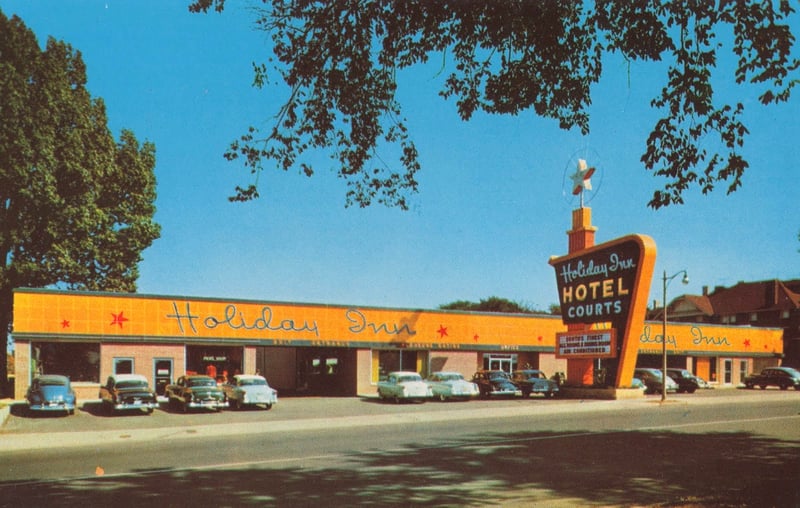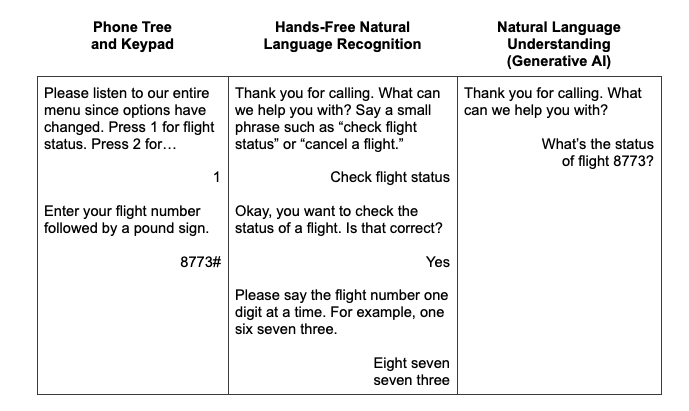In 1951, 38-year-old Kemmons Wilson took his wife and five children, ages two to nine, on a family vacation to the nation’s capital. They drove from Memphis to Washington D.C. Today, that takes 13 hours and maybe twice that 70 years ago. Kemmons was not at all pleased with the roadside hotels they found along the way, so the next year he started the Holiday Inn hotel chain, which grew to 1,000 locations.

Holiday Inn, and the American leisure industry, was a result of the automobile. Ford democratized cars and cars democratized leisure, housing (suburbs), shopping (malls), and many other industries. A couple of generations earlier, steam engine locomotives democratized mail-order shopping and B2B credit. Railroads allowed salespeople to visit many more cities and meet prospective customers they’d never seen before. Their lack of familiarity with a new city and its merchants made credit decisions difficult, so in 1841 Lewis Tappan set up a network of correspondents to aggregate credit information. Lewis’s company still exists today as Dun & Bradstreet.
In the time between Dun & Bradstreet and Holiday Inn, electricity democratized lighting and power appliances and enabled the radio and movie industries. After Holiday Inn, semiconductors democratized computers, video games, publishing, and music production. The point is that technologies such as the steam engine, electricity, automobiles, and semiconductors not only democratize the use case they were developed for, but many other ones as well.
Can Generative AI do that? If so, then when? And what should you do in the meantime?
Seems to me there are a number of possible outcomes for Generative AI, in ascending value:
- It’s just a new user interface, a product feature, like windows and mobile apps.
- The new interface changes customer experience enough that those who implement it well will displace current market leaders, just like Amazon, Apple, and Uber did.
- It’ll democratize many industries and create new ones, like the PC and automobile did.
Just a New User Interface
AWS’s view in April 2023 was that Large Language Models (LLMs) will be added to most apps. Consider the dreaded airline telephone help line. Generative AI is certainly be an improvement over previous interfaces:

The Generative AI feature that Walmart added to their mobile app with Azure is another good example of an improved interface. This type of “feature” capability gets commoditized — like it did for windows interfaces, web interfaces, and mobile apps — and tends to get bundled into big platforms like email and spreadsheets. That might be why AWS and Azure are excited about its widespread adoption. However, maybe Generative AI is more than a feature.
Disruptive User Experience
Few to none would switch from Delta Airlines to United Airlines, or Lufthansa to Ryanair, because of a better automated call center user interface. That industry is dominated by price, routes, and loyalty programs. However, a better user experience can disrupt markets. Amazon displaced Barnes & Noble, Sears, and JCPenney. Apple displaced Nokia and Tower Records. Uber displaced thousands of cab and limo companies. Can Generative AI do that?
Two valuable use cases for Generative AI today are coding and contact center rep copilots which generate 66% and 14% productivity gains, respectively. Is that enough to displace market leaders (e.g., Alorica) if they’re late to adopt it? Probably not near-term, and long-term most competitors will adopt it.
Create New Industries and Democratize Many Services
As many have said the past year, the internet democratized distribution (YouTube, Twitter, Substack, Twitch) and Generative AI will democratize creative production. Personalized images and text generated by AI have increased marketing responses by 40%. Network Rail used AI to create training videos, in many languages with diverse synthetic spokespeople, 95% faster than their previous process. As an Accenture Labs executive said 25 years ago about the value of web-based customer service, that’s the kind of force that sucks rocks off the moon. But video production is a niche market, some say. Yes, today, but democratization will grow it 1,000x.
Capital One’s chief scientist, Prem Natarajan, recently said, “The biggest opportunity for AI is to, in my mind, democratize access to a lot of services, resources, etc., across the entire spread of our social spectrum.” Like automobiles and semiconductors did. So, what will it democratize? I’ve been asking smart people and executives for six months and the consensus is we have no idea. However, you probably noticed that I like looking backward to look forward (it’s Baysian), so Craigslist might provide some insights.

Source: Andrew Parker at Spark Capital
About 15 years after the Cambrian explosion of the web, Andrew Parker at Spark Capital noticed a second-order effect. Craigslist — a free classified advertisements website that covers the entire spread of our social spectrum: dating, jobs, apartments, handyman repairs, childcare, selling your old couch, and more — was being carved up by specialized marketplaces. A few years later those specialists had raised $9 billion in venture capital and today include some of the web’s biggest household names: Uber (market cap $133 billion), Airbnb ($88 billion), LegalZoom ($2 billion), Coursera ($3 billion), Redfin ($1 billion), and Fiverr ($1 billion).
So now specialists will carve up ChatGPT and democratize their services. A few have emerged such as Harvey for law firms, Open Evidence for medicine, DataSnipper for accounting, GitHub Copilot for coding, Glean for enterprise search, Studdy math tutor, QuillBot for writing, Character for companions, ChatPDF for document analysis, Can of Soup for social media image generation, and Soundful for music. (For more, see There's an AI for that’s catalog of 11,000 AIs, OpenAI’s GPT store, and Sequoia Capital’s industry map.)
Specialization is inevitable and valuable, but a more interesting question is what new industries will Generative AI create? What’s ChatGPT’s Holiday Inn? Again, no idea. Maybe new communication modalities. Electricity created the telegraph, radio, movies and TV. PCs gave us YouTube, Twitter, Twitch, and Grand Theft Auto V. Perhaps Generative AI will produce lucid dreams and chatting with your dog.
How Long Will Generative AI's "Between Time' Be?
How long do we have to wait from the primordial ooze we’re in now until we get the Generative AI equivalents of Holiday Inn, Uber, and Airbnb? The Economists recently bemoaned that maybe AI is a bust since corporate capex spending hasn’t increased. Calm down. It’s only been 13 months since the ChatGPT big bang. Some call this the “between time” — the time between an innovation hitting the market and its mass value creation.
The first commercial steam engine was in-market 60 years before James Watt improved its productivity 4x and triggered the first industrial revolution. Thomas Edison commercialized the light bulb 40 years before 50% of households had electricity. Karl Benz started selling cars 32 years before millions were sold. Steve Jobs and Steve Wozniak launched the Apple II personal computer 18 years before 50% of Americans regularly used a PC. But people are impatient, and they tend to overestimate the near-term and underestimate the long-term, even great economists. In the mid 1980s, Nobel laureate economist Robert Solow said that personal computer productivity was everywhere except for the productivity statistics. (It showed up big time 10 years later.)
If we extrapolate the “between times” for steam engines, electricity, automobiles, and personal computers to 2022 when ChatGPT launched, then the estimate is that it’ll take about 10 years, (or nine more years), for Generative AI to create mass value. It could be much shorter since the communication of innovations is a lot quicker today. It took ChatGPT just five days to reach 1 million users, which is 180 times faster than Airbnb. Also, the marginal cost of personal computers, automobiles, and steam engines was high. It was very high for electric lights and toasters since wires had to be run to and through millions of homes.
What is the most valuable text in your organization? Which corpus benefits most from a 20% size increase?
Generative AI apps, on the other hand, are digital so the marginal cost is low and dropping. For example, seven years ago Google’s AlphaZero taught itself to play chess better than any human in just two hours using $25 million of dedicated hardware. That same amount of computation today costs just $3,200. That’s less than a week of the total cost for the average data scientist in the U.S. (5,000 TPUv1s at 30 TFLOPS plus 16 TPUv2s at 45 TFLOPS is 150,000 TFLOPS. Today’s TPUv5 is 400 TFLOPS so we need 375 of them for two hours at $4.20 each per hour for on-demand. After training, AlphaZero played on four TPUv1s whose equivalent computation today is $1.20 an hour.)
What to Do in the Meantime?
Get started now developing apps with Generative AI. The capabilities of ChatGPT, Google Genesis, Anthropic Claude, et al. are so far beyond anything that we’ve seen before that organizations will need time to comprehend them. And they’re improving so rapidly that the gap between leaders and laggards will only grow if you wait. To get ideas on where to start, ask yourself what text is most valuable, and which text collection would most benefit from a 20% increase in size.
There are four natural levels of app complexity to pick from depending on your team’s AI maturity. The first is basic natural language processing tasks such as text summarization, language translation, document classification, and information extraction. For example, summarize a set of customer reviews, classify each review’s sentiment, or extract termination conditions from a contract. A telco used Generative AI to translate marketing messages to many regional dialects, increased responses 40%, and reduced production costs 25%.
The second is prompt engineering and few-short learning to improve results. Retrieval augmented generation (RAG) for custom information retrieval and natural language question-answer apps is third. LG Chem used Dataiku to develop a RAG app for their safety regulations and guidelines. Fourth are chatbots for internal and customer-facing use like Walmart’s and Expedia’s, as well as model fine-tuning and reinforcement learning from human feedback, which is what made ChatGPT so successful. The quicker we get going, the quicker we’ll get through that “between time.”




